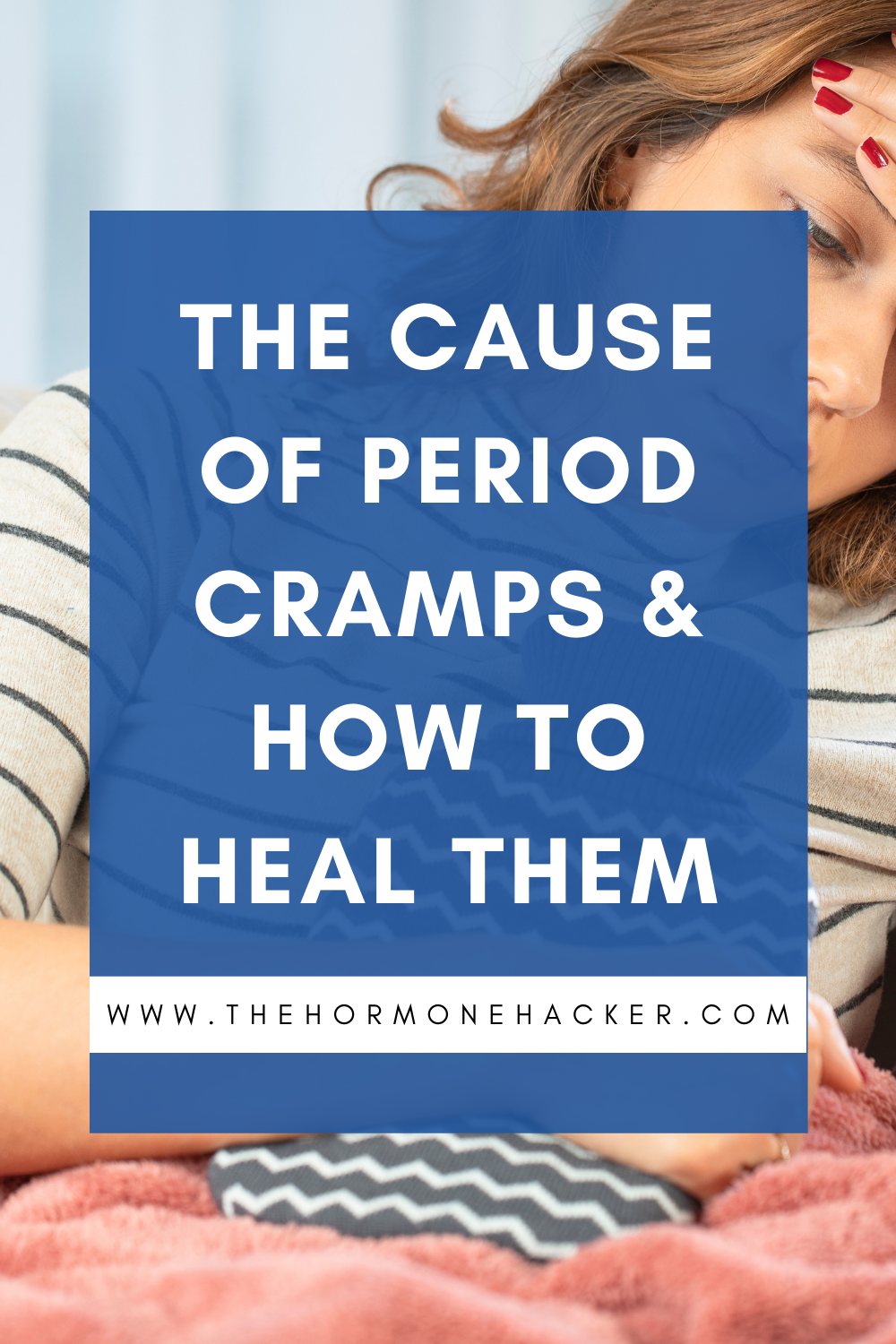If you get menstrual cramps, you’re like most people with periods. But that doesn’t make bad cramps normal. Common, sure-- normal, nope. Don’t worry, though: that means it’s possible to heal your cramps! (*happy dance*)
Quick medical thing: “primary dysmenorrhea” is the fancy term for painful cramps in the absence of other conditions (like endometriosis or fibroids).
You might get some other not-fun symptoms alongside cramps: headaches, nausea, diarrhea, even dizziness.
Wanna kick your cramps to the curb? First, you gotta learn why they happen.
The Root of Cramps: Inflammation & Prostaglandins
You can sarcastically thank prostaglandins for your cramps. Prostaglandins are substances similar to hormones that send signals in response to inflammation.
But not all prostaglandins cause cramps:
PgE2 is the type of prostaglandin that causes uterine contractions (cramps). The more PgE2 your body makes, the more pain and other annoying symptoms you get-- so you want to decrease production of this type.
PgE1 and PgE3 are natural painkillers your body uses to counteract cramps. So, you want to increase production of these types.
They work like this:
Your period is the shedding of your uterine lining. As you approach your period, your body senses inflammation and sends prostaglandins to deal with it.
When that lining starts to break down, the prostaglandins respond by making your uterine muscles contract.
When those muscles contract, they constrict blood vessels and stop blood supply to that tissue.
So, the tissue dies, and the contractions squeeze it out in the form of your period (meaning your period contains tissue, not just blood). Squeezing/contractions = cramps!
The more inflammation, the more prostaglandins respond. That in turn leads to more cramping. Which means… in order to lessen cramps, you need to reduce inflammation.
How to Reduce Inflammation Long-Term
First thing’s first: There is no magic bullet. There’s no single supplement that will stop cramps for good.
Cramps are your body’s way of telling you that something isn’t working optimally. Listen to it, and make the needed lifestyle changes for true health. (You’ll feel better all cycle long!)
A few places to start:
Look at your omega-3 and omega-6 intake.
Your body increases production of PgE2 (the painful one) when you have too much omega-6 fatty acids, and not enough omega-3 fatty acids.
Omega-6 is in highly processed refined oils like canola oil.
Omega-3 is found in flax seeds, walnuts, pumpkin seeds, sesame seeds, chia seeds, eggs, sardines and salmon. Look for linoleic acid.
Increase your intake of omega-3, and decrease intake of omega-6.
2. Manage that cortisol!
If there’s just one thing you’ll do to improve your menstrual health, actually learn to manage stress.
Prioritize 8 hours of sleep every night.
Fully recover from high-intensity exercise.
Eat enough food and balance your blood sugar.
Lessen caffeine and alcohol in the days leading up to your period.
For real, though: Work on balancing your hormones all cycle long-- the effects of your lifestyle the rest of the month affect your period
3. Lessen exposure to environmental toxins
Xenoestrogens are estrogens that come from outside of our bodies. They can mimic your body’s natural estrogen when they enter your body, which can wreak havoc on your endocrine system. This is why they’re called “endocrine disruptors;” they can disrupt your cycle and make symptoms worse!
Xenoestrogens and other toxins are commonly found in
Hormonal birth control
Conventional pads and tampons (RIDICULOUS, I KNOW-- many have dioxins and other chemicals. Look for bleached, organic cotton options, or consider a menstrual cup)
Personal care products (like lotion, soap and perfume) that have synthetic fragrance
Home products (such as dish soap, laundry detergent and cleaners) that have harsh chemicals and synthetic scents
Bisphenol A (BPA) plastics (often in plastic storage containers, water bottles and cans)
Pollution and pesticides
Consuming excessive soy
Lessen your exposure to toxins, and you’ll do great things for your menstrual and overall health. Less period pain for the win!
Cope with Cramps in the Moment
Remember, long-term strategy is what’s really going to help heal you. But, in the meantime, you can deal with cramps by trying out different tools:
Cramp bark is an herbal remedy many cramp-sufferers love. You can take it via capsule or tea.
NSAIDs (like ibuprofen): a word of caution that long-term NSAID use can affect the liver. Ask your doctor about taking a low dose and taking it ahead of when you usually get cramps as a preventative measure (which will lessen the amount of flow).
Some people swear by clary sage essential oil. Use a carrier oil to rub it into your lower abdomen, or add it to an Epsom salt bath (which is also good for cramps).
The good ol’ hot water bottle as you lie on the couch thing. Try it on the lower abdomen and on the lower back, too.
Make your own castor oil packs.
Drinking raspberry leaf tea leading up to and during your period (or even throughout the entire cycle).
Try light movement. Exercising in some way throughout the cycle will do even better.
Consider turmeric, zinc and magnesium supplementation under a doc’s guidance.
When the Cause is Something Else
One more medical thing: secondary dysmenorrhea describes painful periods caused by an underlying condition.
If you suspect something deeper is going on, ask a doc for help. A variety of conditions can cause painful periods, like endometriosis, fibroids, adenomyosis, a tilted uterus, an infection or something else. These often are accompanied by other symptoms.
Real Talk!
You have the right to a pain-free period. I promise.
Put in the work to improve your cycles, and seek outside support when needed.
When you understand how your body works, you can start using the tools and techniques that will help you feel your best every day.
There’s science, and there’s being mindful of that science. You need both!
As always, nothing in this post should be taken as medical advice or diagnosis. Always consult your healthcare provider with your concerns before trying anything mentioned in this post or anywhere on this website.
Sources:
Barcikowska, Z., Rajkowska-Labon, E., Grzybowska, M. E., Hansdorfer-Korzon, R., & Zorena, K. (2020). Inflammatory Markers in Dysmenorrhea and Therapeutic Options. International journal of environmental research and public health, 17(4), 1191.
Durain D. Primary dysmenorrhea: assessment and management update. J Midwifery Womens Health. 2004;49:520-528.
García-Gómez, E., Vázquez-Martínez, E. R., Reyes-Mayoral, C., Cruz-Orozco, O. P., Camacho-Arroyo, I., & Cerbón, M. (2020). Regulation of Inflammation Pathways and Inflammasome by Sex Steroid Hormones in Endometriosis. Frontiers in endocrinology, 10, 935.
Nagata C, Hirokawa K, Shimizu N, Shimizu H. Associations of menstrual pain with intakes of soy, fat and dietary fiber in Japanese women. Eur J Clin Nutr. 2005;59:88-92.
Proctor M, Farquhar C. Diagnosis and management of dysmenorrhoea. BMJ. 2006;332:1134-1138.
Do you get painful periods? How do you deal with cramps?

